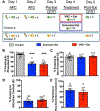Vagus nerve stimulation promotes generalization of conditioned fear extinction and reduces anxiety in rats
- PMID: 30287193
- PMCID: PMC6301121
- DOI: 10.1016/j.brs.2018.09.013
Vagus nerve stimulation promotes generalization of conditioned fear extinction and reduces anxiety in rats
Abstract
Background: Exposure-based therapies are used to treat a variety of trauma- and anxiety-related disorders by generating successful extinction following cue exposure during treatment. The development of adjuvant strategies that accelerate extinction learning, improve tolerability, and increase efficiency of treatment could increase the efficacy of exposure-based therapies. Vagus nerve stimulation (VNS) paired with exposure can enhance fear extinction, in rat models of psychiatric disorders, and chronic administration of VNS reduces anxiety in rats and humans.
Objective: We tested whether VNS, like other cognitive enhancers, could produce generalization of extinction for stimuli that are not presented during the extinction sessions, but are associated with the fear event.
Methods: Male Sprague Dawley rats underwent auditory fear conditioning with two easily discriminable auditory stimuli. Following fear conditioning, extinction training consisted of exposure to only one of the conditioned sounds. Half of the rats received VNS and half received sham stimulation during with sound presentations. VNS effects on anxiety were examined in a separate study where VNS was administered prior to testing on the elevated plus maze.
Results: Sham stimulated rats given 20 presentations of a conditioned stimulus (CS) during the extinction session showed performance that was matched to VNS-treated rats given only 4 presentations of the CS. Despite comparable levels of freezing to the presented CS, only the VNS-treated rats showed a significant decrease in freezing to the CS that was not presented. VNS-induced generalization of extinction was observed only when the two sounds were paired with footshock within the same fear conditioning session; VNS did not promote generalization of extinction when the two sounds were conditioned on different days or in different contexts. On the anxiety test, VNS administration significantly increased time spent in the open arms of the elevated plus maze.
Conclusion: These results provide evidence that VNS can promote generalization of extinction to other stimuli associated with a specific fear experience. Furthermore, non-contingent VNS appears to reduce anxiety. The ability to generalize extinction and reduce anxiety makes VNS a potential candidate for use as an adjunctive strategy to improve the efficacy and tolerability of exposure-based therapies.
Keywords: Anxiety; Extinction; Fear; Generalization; VNS; Vagus.
Copyright © 2018 Elsevier Inc. All rights reserved.
Conflict of interest statement
Conflict of interest:
This work has not been published and has not been submitted for publication elsewhere while under consideration. Authors: Noble, Meruva, and Hays declare no potential conflicts of interest. Dr. Kilgard is a paid consultant for and shareholder of MicroTransponder. Drs. Kilgard and McIntyre are authors of a patent entitled “Enhancing Fear Extinction using Vagus Nerve Stimulation”. Dr. Rennaker is an owner of Vulintis Inc. and Optokinetics and is a paid consultant for Konan Medical USA; none of these financial interests are related to this work.
Figures






References
-
- Rauch S, Foa E (2006) Emotional processing theory (EPT) and exposure therapy for PTSD. Journal of Contemporary Psychotherapy 36: 1–7.
-
- Rosen CS, Chow HC, Finney JF, Greenbaum MA, Moos RH, Sheikh JI, Yesavage JA (2004) VA practice patterns and practice guidelines for treating posttraumatic stress disorder. Journal of traumatic stress 17:213–222. - PubMed
-
- Rothbaum BO, Hodges L, Watson BA, Kessler GD, Opdyke D (1999) Virtual reality exposure therapy for PTSD Vietnam veterans: A case study. Behaviour Research and Therapy 34: 477–481. - PubMed
-
- Kushner MG, et al., (2007) D-cycloserine augmented exposure therapy for obsessive-compulsive disorder. Biological Psychiatry 62: 835–838 - PubMed
-
- Foa EB, et al., (2005) Randomized, placebo-controlled trial of exposure and ritual prevention, clomipramine, and their combination in the treatment of obsessive-compulsive disorder. American Journal of Psychiatry 162: 151–161. - PubMed

